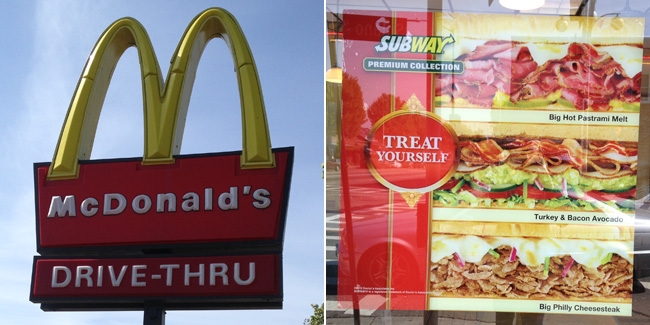
My tween boys, who cringe at the sight of the Golden Arches, answered Subway. It seemed to make sense. Shouldn’t a sandwich chain be a healthier option than a fast-food purveyor of burgers?
Not necessarily so. While Subway may promote itself as the "healthy" fast-food restaurant, it might not be a much healthier alternative than McDonald's for adolescents, according to new UCLA research.
In a study published May 6 in the Journal of Adolescent Health, researchers found that adolescents who purchased Subway meals consumed nearly as many calories as they did at McDonald's. Meals from both restaurants are likely to contribute toward overeating and obesity, according to the researchers.
How can that be?
The researchers found that the participants – 97 adolescents ages 12 to 21 – bought meals containing an average of 1,038 calories at McDonald's and an average of 955 calories at Subway.
"We found that there was no statistically significant difference between the two restaurants, and that participants ate too many calories at both," said Dr. Lenard Lesser, who led the research while a Robert Wood Johnson Foundation clinical scholar in the Department of Family Medicine at the David Geffen School of Medicine at UCLA and the UCLA Fielding School of Public Health.
The Institute of Medicine recommends that school lunches not exceed 850 calories. An adolescent should consume an average of about 2,400 calories in a day.
Among the researchers' other findings:
- The sandwiches purchased by participants contained an average of 784 calories at Subway versus 572 calories at McDonald's.
- Participants purchased sugary drinks averaging 61 calories at Subway and 151 calories at McDonald's.
- Customers in the study purchased side items such as french fries and potato chips that added an average of 35 calories at Subway compared with 201 calories at McDonald's.
- Participants consumed 102 grams of carbohydrates at Subway; 128 grams at McDonald's.
- The meals contained an average of 36 grams of sugar at Subway; 54 grams at McDonald's.
- Meals contained an average of 41 grams of protein at Subway; 32 grams at McDonald's.
- Sodium intake averaged 2,149 mg at Subway; 1,829 mg at McDonald's.
"The nutrient profile at Subway was slightly healthier, but the food still contained three times the amount of salt that the Institute of Medicine recommends," said Lesser, who is now a researcher at the Palo Alto Medical Foundation Research Institute.
What would Jared do?
My sons suggested eating a smaller sandwich with less meat. For example, a Subway 6-inch turkey breast sandwich has 280 calories, while a footlong Big Philly Cheesesteak has 1,000 calories.
Lesser, who recommends that McDonald's customers eliminate sugary drinks and french fries from their meals, had similar advice: “If you go to Subway, opt for smaller subs, and ask for less meat and double the amount of veggies," he said.
More veggies – I’m lovin’ that.